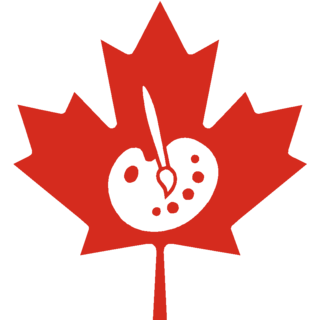
Florence Helena McGillivray, also known as F H. McGillivray, was a Canadian landscape painter known for her Post-Impressionist style. Her family home was in Whitby, Ontario. She was also a teacher. In 1916, on a visit to his studio, she encouraged Tom Thomson.

Laurel Nakadate is an American feminist video artist, filmmaker, and photographer. She is based in New York City.
Lynn Richardson is a Canadian artist and sculptor based in Winnipeg.

Rebecca Belmore is an interdisciplinary Anishinaabekwe artist who is particularly notable for politically conscious and socially aware performance and installation work. She is Ojibwe and member of Obishikokaang. Belmore currently lives in Toronto, Ontario.
Laura Fritz, is a Portland, Oregon based installation artist who incorporates sculpture, light and video.

The Professional Native Indian Artists Incorporation (PNIAI), informally known as the Indian Group of Seven, was a group of First Nations artists from Canada, with one from the United States. Founded in November 1973, they were Indigenous painters who exhibited in the larger art world. The nickname is an allusion to the Group of Seven, a Euro-Canadian group of painters from the early 20th century.
KC Adams is a Cree, Ojibway, and British artist and educator based in Winnipeg, Manitoba.
Lita Fontaine is an interdisciplinary artist based in Winnipeg, Manitoba. Often, her work explores the role of women in past and present Indigenous societies. She describes herself as tri-cultural: Dakota, Anishinaabe and Metis.
Ruth Cuthand is a Canadian artist of Plains Cree and Scottish ancestry. She is widely considered an influential feminist artist of the Canadian prairies, and is lauded for her unflinching interpretation of racism and colonialism. Her work challenges mainstream perspectives on colonialism and the relationships between settlers and Indigenous people in a practice marked by political invective, humour, and a deliberate crudeness of style.
Ann Harbuz (Napastiuk) was a Canadian artist. A self-taught artist, she is known for folk art painting depicting 20th-century Canadian Ukrainian prairie perspectives. She drew inspiration from her rural and Ukrainian origins in Western Canada, reflecting her very personal vision of the social life of her community, a vision which is a combination of memories, dreams and reality. While her art career began late in life, she produced more than 1000 paintings and painted objects.
Michelle LaVallee is a Canadian curator, artist, and educator. She is Ojibway and a member of the Chippewas of Nawash Unceded First Nation in Cape Croker, Ontario. She has BFA (2000) and BEd (2004) degrees from York University in Toronto.
Sheila Butler is an American-Canadian visual artist and retired professor. Her collections are featured at the National Gallery of Canada, the Art Gallery of Hamilton, the University of Toronto, the Winnipeg Art Gallery and University of Manitoba in Winnipeg. She is a founding member of Mentoring Artists for Women's Art in Winnipeg, Manitoba and the Sanavik Inuit Cooperative in Baker Lake, Nunavut. She is a fellow of the Royal Canadian Academy of Arts.
Leesa Streifler is a Canadian multi-disciplinary artist and art professor who lives in Winnipeg, Manitoba. Her works have been exhibited extensively in solo and group exhibitions, nationally and internationally, and appear in the permanent collection of the National Gallery of Canada and the Canadian Museum of Contemporary Photography.
Carmen L. Robertson is a writer and scholar of art history and indigenous peoples. She was born in Balcarres, Saskatchewan, of Lakota and Scottish ancestry. She is Canada Research Chair in North American Art and Material Culture in the Faculty of Arts and Social Sciences at Carleton University. Before joining Carleton, Robertson was an associate professor in the Faculty of Media, Art & Performance at the University of Regina (2006-2012). She also served as the Indian Fine Arts department head at the First Nations University of Canada where she taught from 2000-2006. A number of Robertson's writings focus on the Aboriginal Canadian artist Norval Morrisseau. She is past president of the Native Heritage Foundation of Canada.
Alicia Dawn Popoff was a Canadian abstract painter who worked primarily in acrylic and sometimes mixed media. She also worked in sculpture, sometimes collaborating with her husband and fellow artist and sculptor Leslie Potter. Popoff's work has been exhibited across Canada in numerous exhibitions and commercial galleries and can be seen in public and corporate collections.
Eva Koves Stubbs was a Hungarian-born Canadian artist and educator.
Deirdre Logue is a Canadian video artist and arts administrator, based in Toronto, Ontario.
Nancy Dillow, born Nancy Elizabeth Robertson, was a Canadian museum director, curator and writer.
Louise Noguchi is a multidisciplinary visual artist who uses video, photography, sculpture, and installation to examine notion of identity, perception and reality.
Caroline Dukes was a painter and installation artist, born in Hungary but moved to Winnipeg, Manitoba in 1967. Today, she is considered a Manitoba artist.


